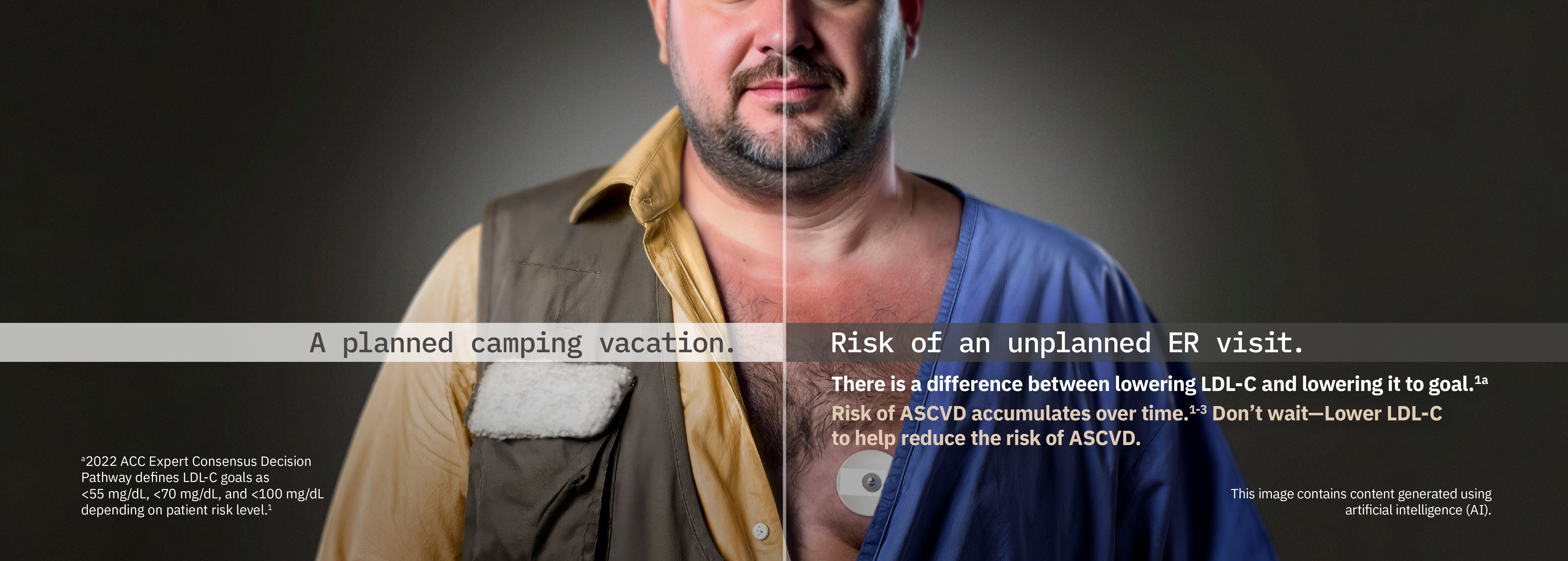This site is intended for US Healthcare Professionals Only.

Modeling Suggest that the Longer LDL-C Remains Above Goal, the Greater the ASCVD Risk.2,3
Linear regression models suggest that the duration of elevated LDL-C exposure may directly correlate with increased risk of CVD and ASCVD events2,3
One predictive modeling study suggests that every 100 mg/dL times the number of years of LDL-C exposure raises the relative lifetime cardiovascular risk by 5.3%.2b
bData from the CARDIA study, a multicenter longitudinal cohort study that enrolled 5115 healthy individuals from 1985-1986 to study the association of cumulative exposure to LDL-C with subsequent CVD events. In this landmark analysis, the CVD risk-prediction model was based on cumulative LDL-C exposure and other risk factors at age 40 years. Forty years of age was chosen as a landmark age to provide approximately equal intervals for measuring LDL-C exposure and accumulation during young adulthood and follow-up for subsequent events in middle age and older life. Study limitations include a mean age of 56 years at current follow-up for the study population, with 275 fatal and non-fatal CVD events. Therefore, the population is too young to study each component of the composite endpoint (non-fatal coronary heart disease, stroke, transient ischemic attack, hospitalization for heart failure, cardiac revascularization, intervention for peripheral artery disease or death from cardiovascular causes) separately, due to limited statistical power.2
A meta-analysis of 53 clinical trials suggested that lowering LDL-C by 38.7 mg/dL reduced the relative risk of major adverse CV events by ~20%.4c
cBased on a meta-analysis of 53 randomized controlled trials (329,897 patients). Twenty trials were conducted in secondary prevention, 12 trials in primary prevention, and 19 trials enrolled a mixed cohort. Meta-analysis was stratified according to the baseline LDL-C thresholds.4
A modeling study suggests that cumulative ASCVD risk can be mitigated by reducing LDL-C and maintaining lower levels over time.2
Support your patients by helping them get to LDL-C goal
ACC ECDP=American College of Cardiology Expert Consensus Decision Pathway; ASCVD=atherosclerotic cardiovascular disease; CARDIA=Coronary Artery Risk Development in Young Adults Study; CHD=coronary heart disease; CVD=cardiovascular disease; HF=heart failure; LDL-C=low-density lipoprotein cholesterol; MI=myocardial infarction. PAD=peripheral artery disease; TIA=transient ischemic attack.
References: 1. Writing Committee; Lloyd-Jones DM, Morris PB, et al. 2022 ACC Expert Consensus Decision Pathway on the Role of Nonstatin Therapies for LDL-Cholesterol Lowering in the Management of Atherosclerotic Cardiovascular Disease Risk: A Report of the American College of Cardiology Solution Set Oversight Committee. J Am Coll Cardiol. 2022;80(14):1366-1418. doi:10.1016/j.jacc.2022.07.006 2. Domanski MJ, Tian X, Wu CO, et al. Time Course of LDL Cholesterol Exposure and Cardiovascular Disease Event Risk. J Am Coll Cardiol. 2020;76(13):1507-1516. doi:10.1016/j.jacc.2020.07.059 3. Ference BA, Braunwald E, Catapano AL. The LDL Cumulative Exposure Hypothesis: Evidence and Practical Applications. Nat Rev Cardiol. 2024;21(10):701-716. doi:10.1038/s41569-024-01039-5 4. Khan SU, Michos ED. Cardiovascular Mortality After Intensive LDL-Cholesterol Lowering: Does Baseline LDL-Cholesterol Really Matter? Am J Prev Cardiol. 2020;1:100013. doi:10.1016/j.ajpc.2020.100013
